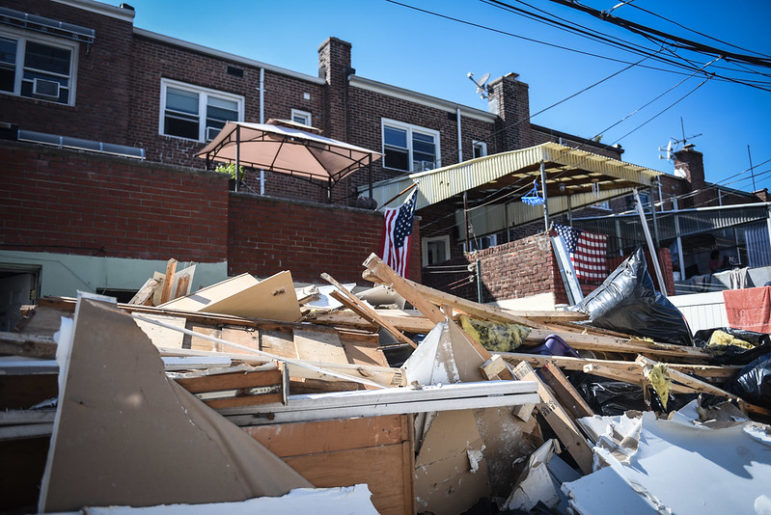As of Dec. 13, 501 applications for the $27 million fund have been completed and signed by a caseworker, 145 have been approved, 66 have received the aid and 79 are in the process of receiving it.

Kevin P. Coughlin / Office of the Governor
Flooding in Queens following Hurricane Ida.Lea la versión en español aquí.

The number of applicants who’ve received aid from the $27 million Ida relief fund created for undocumented New Yorkers has doubled in recent weeks, after a two-month slow start.
Only 32 applicants had previously received the funds as of Nov. 24, just days before the application period was set to close, City Limits previously reported. The state then extended the deadline to Jan. 4, hoping to get the word out to more potential applicants. In a September assessment report, the city estimated that the storm—which brought flash floods that killed more than a dozen people—affected some 5,100 undocumented immigrants.
In recent weeks the relief program has taken off, and the eight community-based organizations (CBOs) in charge of both the application process and distributing the funds reported that thousands of people have sought assistance for damage caused by the remnants of Hurricane Ida.
As of Dec. 13, 501 applications have been completed and signed by a caseworker, according to Mercedes Padilla, a spokesperson for New York’s Department of State. Of the 145 approved, 66 applicants have received the aid and 79 are in the process of receiving it.
Make the Road New York, one of the CBOs administering the fund, has seen the bulk of the interest: 1,300 calls or walks in, 285 applications that have been initiated, and 71 households approved as of Dec. 13. Some $418,000 in aid has been approved in total, and $209,000 has already been dispersed to 41 households, according to Becca Talzek, deputy director of Make the Road New York.
Catholic Charities Community Services (CCCS) reported that as of Dec. 14, 39 people have met eligibility requirements for the Ida relief fund and are working with a case manager to collect documentation; four so far have been approved.
CBO workers involved in the program said most of the people seeking aid so far have been referred instead to the Federal Emergency Management Agency (FEMA). Families who have U.S.-born children or are a mixed-status family are eligible for FEMA aid, and therefore do not qualify for the city and state joint relief assistance funds.
“It’s not uncommon to find people impacted by a disaster who do not even apply to FEMA, despite how well-known the program is and the extensive outreach that FEMA does,” said Julianne Pannelli, director of special projects at CCCS, another CBO selected.
“There has never been a program like this before, so there is a lack of familiarity,” Pannelli added. “So it isn’t surprising that a new program designed for a population that may already be fearful has had fewer applications than expected.”
Hesitancy played a role in the lack of interest at the beginning as well. “Many of the community members that we spoke to were hesitant to apply or visit because they are not sure if they can get any assistance due to their status,” said Benjamin Eng, Ida relief fund program coordinator at the Chinese-American Planning Council, where 14 applicants have been approved as of Dec. 8.
“They were also afraid that if they spoke with us, they will get in trouble. Some also informed us that they didn’t believe that this program exists because there aren’t many programs that help the undocumented community members,” Eng added.
Being referred to FEMA has been a great surprise for most because they didn’t know they could apply for the federal aid, Talzek explained. Applicants may be eligible for FEMA assistance using their child’s Social Security number if they are the parent or guardian of a minor who is a United States citizen, non-citizen national, or qualified alien—who may also be eligible for assistance themselves.

Michael Appleton/Mayoral Photography Office
Ida aftermath in Queens.
New York’s Department of State reported that out of the more than 2,000 people who have called the New York State Office for New Americans (ONA) Hotline or walked in to ask about the relief fund for undocumented workers, 594 have been referred to FEMA instead. Make the Road New York alone has referred 340 applicants to FEMA and CCCS has referred 39 out of 113 who have reached out.
But not all CBOs have seen the same pattern. MinKwon Center for Community Action reported the opposite: they referred only 30 to FEMA out of the 150 applicants they have been communicating with. As of Dec. 15, 60 have already applied for the relief aid, according to Min Soo Kim, MinKwon’s special projects associate for the fund.
Documentation hurdles
The city and state Ida relief program provides a maximum of $72,000 (up to $36,000 in grants for housing-related assistance and up to $36,000 in assistance for other needs), but CBOs noted that providing proof of residence has been the most common problem applicants faced.
“There is difficulty showing occupancy. They have no leases. Or if they had them, the water took it away,” said Carola Otero Bracco, Neighbors Link’s executive director.
CBOs like Make The Road and MinKwon report that most of the applicants who’ve sought help have been tenants living in sub- or at-grade spaces that proved to be lethal during the storm, prompting renewed attention and debates about how the city should handle basement apartments. “More than half of the cases I think,” noted Talzek.
For some applicants, providing photos, videos, or receipts of expenditures has been a challenge. The program was not announced until 25 days after Ida hit New York; during that time, storm victims were more focused on surviving than on documenting every step of their loss.
“It is a little late because a lot of our community members were not aware that this program was going to exist. If they knew earlier, some may be able to provide better documentation. But I am glad that the program exists,” he remarked.
Of the funds distributed so far, very few applicants have received direct housing assistance: just $34,024 compared to $299,876 who have been paid to alleviate what the program considers to be “other needs assistance” expenses, which covers things like vehicle damage, moving costs, childcare and others.
Low housing assistance disbursement is not indicative of a lack of demand though. “A lot of our community members are asking us for rental assistance,” explained Eng. “Due to this program’s guideline, rental assistance is for members who are unable to live in the damaged property and are currently living/looking for a new place. The problem with that is a lot of members cannot afford to find a new place, and some are still living at the damaged place.”
Gov. Kathy Hochul extended the deadline to apply for the Ida Relief Fund through Jan. 4. If the current pace of application and approvals continues, it’s unlikely the $27 million fund will be exhausted within the less than three-week application period left.
City Limits asked if the State would push the deadline back again. A spokesperson said they will “evaluate and look for other opportunities,” as the end date approaches. The state declined to say what it would do with any remaining funds that aren’t distributed; advocates say the money could be used to create a permanent relief fund for undocumented immigrants who are victims of future storms.
“I think it definitively should be a permanent program,” said Talzek, who added that the creation of a permanent fund through legislation would be another option.








